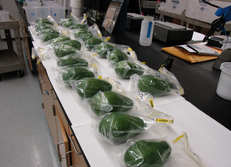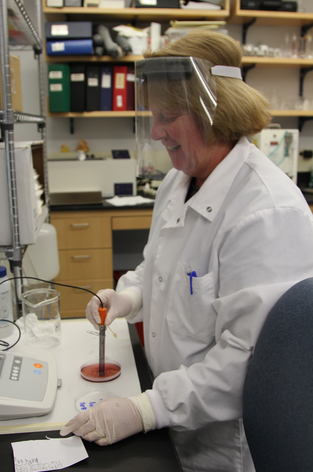There's What In My Food?
Foodborne disease occurs when an individual becomes ill as a result of consuming food containing a pathogen. Some newsworthy pathogens you may have heard about recently include Salmonella, E. coli, and Listeria. One in six people become ill from foodborne disease each year, and thousands succumb to death. Public health laboratorians, through the identification and DNA fingerprinting of pathogens from sick people, food, or environment samples, are at the forefront of resolving such outbreaks.
Foodborne disease occurs when an individual becomes ill as a result of consuming food containing a pathogen. Some causative agents that have made it into the news lately include Salmonella, E.coli, Listeria and many more. The CDC estimates that 48 million cases of foodborne illness occur each year. That’s 1 in 6 people! Approximately 128,000 require hospitalization and 3,000 die. You have probably heard of foodborne illness in the news too.
Foodborne illnesses continue to challenge public health in the US and worldwide. It is thought that a number of factors may contribute to the recent increase in the number of reported foodborne-related illnesses. These include changes in human behaviors such as an increased consumption of fast foods, changes in industrial technologies associated with food processing, increased international travel, and the emergence of bacteria with a greater ability to cause severe illness. Public health laboratory scientists are on the frontline of defense, providing testing that determines which microbes are present in sick individuals. This work, along with testing food and environmental samples and DNA fingerprinting, provides the needed testing to SOLVE foodborne disease outbreaks in a judicious manner.
Foodborne illnesses continue to challenge public health in the US and worldwide. It is thought that a number of factors may contribute to the recent increase in the number of reported foodborne-related illnesses. These include changes in human behaviors such as an increased consumption of fast foods, changes in industrial technologies associated with food processing, increased international travel, and the emergence of bacteria with a greater ability to cause severe illness. Public health laboratory scientists are on the frontline of defense, providing testing that determines which microbes are present in sick individuals. This work, along with testing food and environmental samples and DNA fingerprinting, provides the needed testing to SOLVE foodborne disease outbreaks in a judicious manner.
Resources:
Lesson Plans & Experiments
The Teachers Guide: Your Game Plan for Food Safety
Make Your Own Hand Sanitizer
- The program includes DVDs, posters, experiments, and more. Teach your students how quickly bacteria can multiply at warm temperatures or the importance of using cold temperatures to slow growth.
- http://www.fightbac.org/wp-content/uploads/2015/07/fight-bac-curriculum-book.pdf
Make Your Own Hand Sanitizer
- Good hand hygiene is an important step to prevent infection with the influenza virus and other microorganisms. If you are unable to wash your hands with soap and water, decontaminating your hands with hand sanitizer is also a good preventive measure.
- http://www.michigan.gov/documents/explorelabscience/Fall_2012_Newsletter_400551_7.pdf
Growing Bacteria/Agar Lab
FBI Case: Perils at the Picnic
Home Food Safety Survey
- Students learn about agar plates and bacterial growth by making the plates and culturing bacteria from classroom surfaces. Students can also add a drop of hand-sanitizer and look for different results.
- Growing Bacteria/Agar Lab PDF
FBI Case: Perils at the Picnic
- This case study describes a scenario in which children become the detectives on the case of a foodborne illness.
- http://www.fightbac.org/grades4-8fbicase.pdf
Home Food Safety Survey
- This survey provides a tool for students to use to help them determine if they are fighting BAC! at home.
- http://www.fightbac.org/grades4-8survey.pdf
Games & Apps
Mapping Disease Spread
Solve the Outbreak
Pathogen Tracker
Fight BAC! Game
- A team from Boston Children’s Hospital uses online sources for disease outbreak monitoring and real-time surveillance of emerging public health threats in order to facilitate early detection.
- http://www.healthmap.org/en
Solve the Outbreak
- In this fun, interactive app the student becomes a Disease Detective and travels the world chasing outbreaks like the real-life ones public health laboratory scientists and CDC Disease Detectives help fight.
- http://www.cdc.gov/mobile/applications/sto/sto-web.html
Pathogen Tracker
- This online game has been created as a fun challenge for anyone interested in learning more about the spread of foodborne illnesses and how online databases can help track down the source of the organisms that cause them.
- http://game.pathogentracker.net
Fight BAC! Game
- This is a fun tool for teaching children how to fight BAC! against foodborne illnesses
- http://www.fightbac.org/wp-content/uploads/2015/07/grades4-8bacgame.pdf
Videos
How Our School Fought BAC
Foodborne Illness: What Problem?
Virginia's Laboratory Testing for Foodborne Illnesses
- This is a 20 minute video that accompanies the FightBAC Teacher’s Guide
- https://www.youtube.com/watch?v=HHtVoFRwzHE
Foodborne Illness: What Problem?
- This production is the first in a series of seven videos. It introduces novice outbreak investigation team members to the concept of foodborne illness and the current health and financial burden it has in the US. This video also offers a historical perspective on the changes that have occurred within the food industry and their effects on public health and food safety professionals today.
- https://www.youtube.com/watch?v=2QQvhFPZedM
Virginia's Laboratory Testing for Foodborne Illnesses
- WWBT Channel 12 takes a look at what is involved when detecting foodborne illnesses. Speaking with the Division of Consolidated Laboratory Services in the Department of General Services and with the Virginia Department of Health, this news story shows the lab testing that occurs, and why it can be so difficult to determine if an illness is foodborne.
- https://www.youtube.com/watch?v=5Guq1TAaTq8
If you want to know more...
Some recent and widespread foodborne outbreaks and recalls include:
Fight BAC!
Cornell University’s Middle and High School Teacher Food Safety Resources
- Salmonella in peanut butter and other products
- E. coli in bagged spinach, cookie dough and more
- Clostridium botulinum in canned chili
Fight BAC!
- Fight BAC is a non-profit partnership for food safety education. The website is a great resource for activities, videos, and experiments specifically developed to teach students how to safely handle food and how to prevent foodborne illnesses around the school and community.
- http://www.fightbac.org/
Cornell University’s Middle and High School Teacher Food Safety Resources
- This site is a collection of resources to introduce students to food safety through fun and interactive games and materials.
- https://confluence.cornell.edu/display/FOODSAFETY/
Have questions or feedback? Contact us at [email protected].




